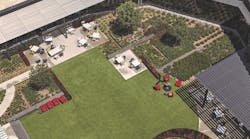The age of the gray and drab office is over. Today’s occupants expect more from their workplace and are looking for environments that match their values and lifestyle – spaces where they can work, relax and play. As you search for ways to cut through the competition, consider a usable rooftop.
Retrofitting an existing rooftop into things like a garden, park or event space can appear daunting. “It’s a very specialized application,” says Brian Lambert, director of products for The Garland Company, a manufacturer of roofing and building envelope solutions. “It has to be the right setting, the right roof and the right application.”
But roofing professionals and architects agree: When done properly, a usable rooftop is worth the investment.
(Photo: About a third of the Dansko building’s roofs in Chester County, Pennsylvania are vegetated. One roof has a patio with a pergola and is accessible to employees. Credit: The Garland Company)
Benefits of a Usable Rooftop
Usable rooftops can attract occupants and potential employees to your building – an added bonus for tenants are who trying to draw top talent. Occupants also want amenities that improve wellbeing.
“As we densify our cities more and more, [creating a usable rooftop] is an opportunity to think outside the box,” says Jeff Paine, a founding principal of architect and design firm Duda|Paine. “Yes, it’s an additional expense, but as humans our need to be connected to nature and outdoors – not paving and sidewalks everywhere – can be met.”
[Read also: Biophilia Study: Keys to Employee Health and Wellness]
Rooftop spaces can also contribute to your building’s sustainability. Consider whether retrofitting your roof for solar panels is the right move. Green rooftops are beneficial for water management and lessening heat exposure.
“These systems often have some sort of overburden or pavers, so [the roofs] are not exposed to heat,” says Lambert. “These systems protect from harsh elements, and since it’s a protected system, they tend to last a long time.”
Parking garage rooftops are a prime example of creating a green space to stave off heat gain. “All concrete is absorbing solar heat gain, so by putting something up there that’s not concrete, you’ve really improved the environment,” says Turan Duda, also a founding principal at Duda|Paine. “I do think for a building manager it will be something that begins to translate back to their operational funds.”
What to Consider
Before you start making decisions on retrofitting your rooftop into a usable space, make sure it’s the right fit for your building. Lambert recommends asking yourself these questions before beginning the process.
- What is the rooftop system you want to put down?
- Is it designed to last a long time?
- Will it be designed and detailed properly?
“Putting the best roof system down and making sure details are accurate is the most critical piece of any of these spaces,” he adds.
[5 Trending Tenant Amenity Ideas for Your Facility]
When considering a rooftop retrofit, roofing professionals and architects agree that you should focus on these five practical items:
1. Quality of views
What will the views be? Are they worth the cost? It might sound like an obvious question to ask yourself, but it’s vital for investing in a rooftop space.
“You spend all this money, and you go up on the roof – great. But what are you looking at? The side of another building?” says Gerry Tierney, associate principal at architecture and design firm Perkins+Will’s San Francisco office.
“Not all roofs are created equal. You could be in another place where you’re surrounded by four taller buildings. You really don’t have a view at that point. You have to sit down and consider if this is this the best use out there. You have to be realistic,” he continues.
2. Structural load capacity
Make sure your rooftop can function with what you’re asking it to do. Retrofitting an accessible rooftop space adds a lot of extra weight, so be aware of structural load and building code requirements.
Help BUILDINGS Shape 2019!
What BUILDINGS resources are most valuable to you? What would you like to see us provide?
Please take our short (under 2 minutes) survey - just 5 short questions.
Thank you!
“If I were a facilities manager, I would make sure I understood what those requirements are or hire a design professional that certainly understood those additional requirements,” Lambert says.
3. Accommodating mechanical equipment
Be aware that you need to accommodate any HVAC or other mechanical equipment positioned on your rooftop. “You have to fight against rooftop ductwork and equipment and piping, which really were never set up to accommodate a roof space,” Tierney says.
If you are able to work around that equipment, make sure it doesn’t affect the desired ambiance of the new space.
“You don’t want to go up onto this great roof deck that you spent all of this money on and now you’re looking at the side of an air conditioner,” Tierney adds. “And even if you’re not looking at that, how do you not listen to it?”
4. Accessibility
Your new rooftop space should be accessible and ADA-compliant. Retrofitting presents this additional problem. The Bay Area Metro Center, designed by Perkins+Will, boasts a terrace on the top floor because the building’s elevator didn’t reach the rooftop level. Architects also designed a short ramp to go up the landing for greater accessibility.
5. Waterproofing
Lambert says waterproofing is the most important consideration for any type of rooftop system. Will it be able to keep out water for a long time? Avoiding leaks is critical. “There’s nothing worse than putting a green roof down that looks really pretty, and it leaks; or a nice outdoor patio area that’s really attractive, and it leaks,” he says.
He argues that waterproofing is especially important for a usable rooftop. “If there’s a problem [on a conventional roof], you can go fix it – it’s easy to get to and solve the problem. But when you cover it, that’s when it’s a lot more difficult, time-consuming and expensive to go hunt down the problem. Make sure you do it right the first time.”
Tierney says today’s waterproofing technology should soothe any concerns.
[Related: Top 5 Envelope Failures and Water Leaking Solutions]
“Any building owner, when you say you want to put a park or garden up there, they go weak at the knees thinking of lawsuits and leaks,” he says. “The fact of the matter is all of the detailing and waterproof membranes have gotten more sophisticated. We understand best practices now that will allow you to put something up there and not let it leak. Ten to 15 years ago, that might not have been the case.”
(Photo: Located in Raleigh, NC, The Dillon features a “pocket park” terrace that is completely open to the public. Credit: Kane Realty)
Wow Factor
Incorporating thoughtful elements into the design of your rooftop space can make it a step above the rest. The Bay Area Metro Center brings together four regional agencies, including the Metropolitan Transportation Commission (MTC).
Under the MTC is the Bay Area Toll Authority, which oversees the city’s state-owned toll bridges. With that in mind, Perkins+Will designed the building’s top-level terrace to have a view of the Bay Bridge.
“We thought since they’re up there and this is their job, with the view of the Bay Bridge, wouldn’t it be great if they could see it?” Tierney says. The metro center also incorporates salvaged material from the San Francisco Transbay Terminal.
The sky garden at the NCR Global Headquarters in Atlanta is located on the rooftop of a parking structure that connects two buildings. Glass doors from the food hall lead out onto the garden, and it often serves as a meeting point for people who work in the two different buildings.
(Photo: NCR’s sky garden is located on the rooftop of a parking structure that connects two buildings. It often serves as a meeting point for people who work in different buildings. Credit: Robert Benson Photography)
“The project is intended to reach out to the next generation of creatives and young people coming out of Georgia Tech and elsewhere,” says Duda. “We wanted to create an environment that’s going to be a draw and will draw talent.”
Duda expects usable rooftops to only increase in popularity. “Anything we can do to humanize them is an improvement.”
Tierney adds, “When you do provide them, it’s a real wow factor.
Two handpicked articles to read next:



